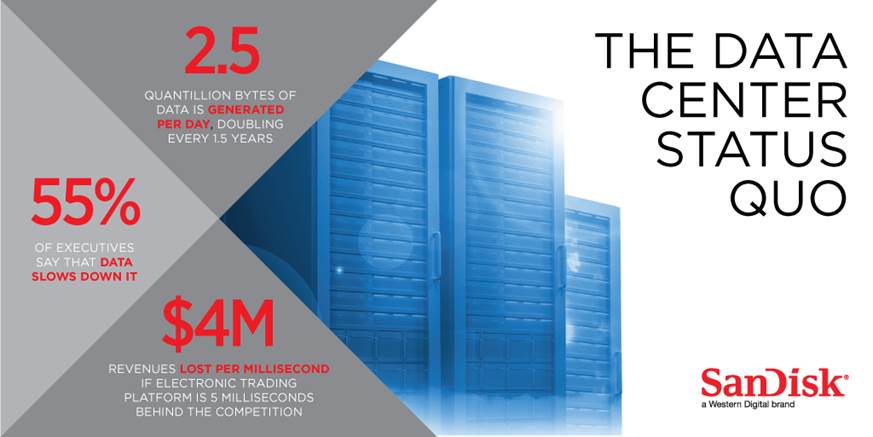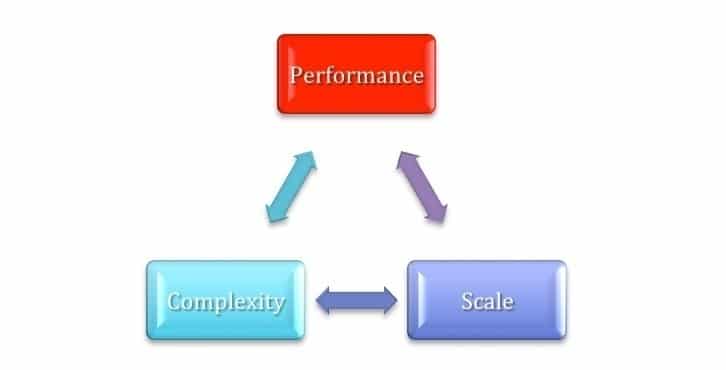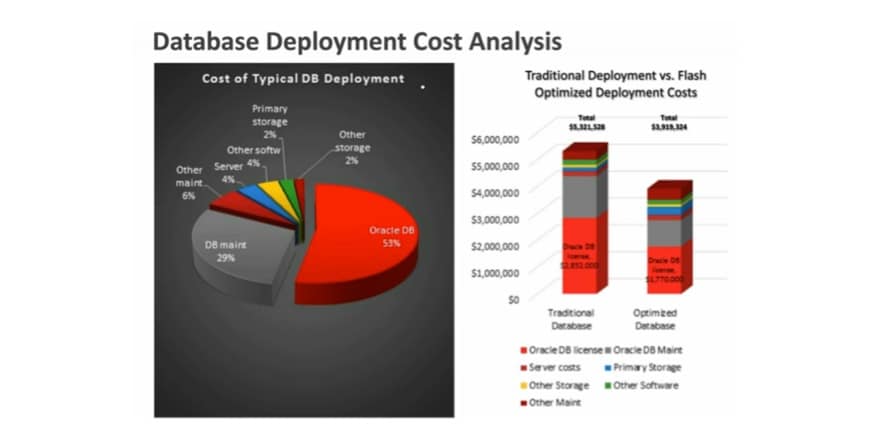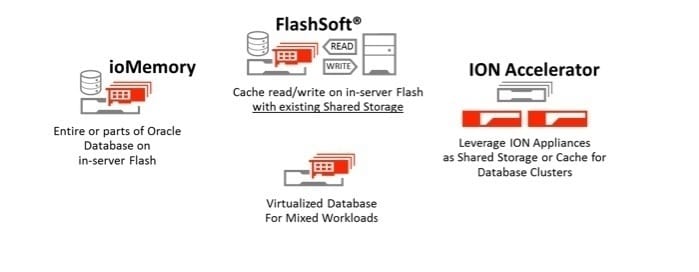3 Steps to Modernize Your Oracle Data Center
Your company may be one of many continually pouring money into new server hardware and software licenses but still coming up short on performance. If so, save that money – and your job – by learning how to modernize your Oracle data center architecture.
The Status Quo Of The Data Center
2.5 |
55% |
$4M | ||
| Quantillion Bytes of data is generated per day, doubling every 1.5 years | Of executives say that data slows down IT | Revenues lost per millisecond if electronic trading platform is 5 milliseconds behind the competition |
These three numbers outline the very core challenge everyone in IT is up against:
- We store a lot of data, and it’s not going to stop growing
- This growing amount of data is slowing down our entire IT infrastructure
- Slowing performance is costing us real dollars (and this is not just the giants of the web but for business of all shapes and sizes).

The Data Center’s IT Tension
Many IT professionals out there are being pulled into different directions simultaneously. We call the Data Center IT Tension Triangle. We are being pulled between delivering performance, scale and complexity all at once.

Solving challenges in one of these areas typically creates challenges with the other(s): scale up with the technology you currently have, and most likely you will suffer from lower performance of your systems if you don’t invest in faster networking, CPU, power, cooling etc. Increase your performance, and you realize that you increase complexity. And all of that is expected to be accomplished with either static or even shrinking budgets.
So what to do? Here are three critical tips.
[Tweet “3 Steps to Modernize Your #Oracle #DataCenter with Flash”]
Step 1: Eliminate Storage Bottlenecks Where Possible
Let’s start by thinking about where we can improve storage performance. Most data today is still stored on spinning hard disk drives (HDD). While the capacity of HDDs has significantly increased over the past 10-15 years, performance hasn’t, causing a significant performance gap between the CPU in a server spinning media. This isn’t going to change much as HDDs are limited in their future capacity and performance by simple physics.
We all know flash storage is fast. And it’s a technology that’s evolving and progressing to be even faster and provide greater capacity. Flash storage continues with a long roadmap ahead as it based on similar semiconductor technology as CPUs.
Another good reason to utilize flash is the wide breadth of solution available to solve customers’ individual challenges. Whether as HDD replacement (SAS and SATA drives), in-server accelerator (PCIe and Flash Caching), external accelerated storage repository like the ION Accelerator or the industry leading capacity of the new InfiniFlash solution – flash comes in all shapes and sizes with different capabilities and varying prices tags to fit your exact needs.
Step 2: Consolidate Hardware
While at a first glance flash solutions may seem more expensive when compared on a device-to-device or cost per-GB basis, when examined from a broader perspective can provide significant cost savings and improved ROI.
In Oracle database deployments, the overall cost for primary storage is just a fraction of the overall costs while software licenses and database maintenance comprise almost three quarters of the overall expenses.
Take a look at the graphic below:

As you can see from the Wikibon research, utilizing faster and optimized storage using flash can actually shrink the overall costs dramatically!
For example, by putting the database on the PCI bus of the server, read and write speeds increase dramatically. This will not only deliver better performance with fewer devices, it will also help lower CPU utilization, reducing the number of required CPU cores and the associated Oracle licenses which can significantly reduce costs. Those systems will also run smoother, faster and more efficiently on flash storage, which brings down the costs for database maintenance as well.
Step 3: Pick What to Accelerate
We often talk about the fact that one of the great benefits of flash is that it’s not a ‘one size fits all’ solution. There are multiple ways to accelerate your database performance with SanDisk® data center flash solutions:
- Flash cache: Accelerate reads with SanDisk FlashSoft Software or Oracle Database Smart Flash Cache
- Hybrid: Store and accelerate key parts of the database on Fusion ioMemory PCIe application accelerators
- All-Flash: Store and accelerate the entire database on ioMemory PCIe application accelerators, ION Accelerator and InfiniFlash solutions/
- Offload: Offload SAN and ASM preferred read mirrors
- Replication: Accelerate replication and High Availability

With solution that address the three key challenges of the data center—performance, scale, and complexity—IT managers find that they don’t have to compromise. In fact they start seeing great benefits:
- Revenue: with flash, more customers and transactions are supported simultaneously, and actionable data is accessed faster to help drive revenue.
- Cost: with flash you can consolidate infrastructure, reduce management time to increase employee productivity, and leverage your existing SAN investment.
- Quality: with flash you can better meet your Service Level Agreements, and service customers more quickly with predictable performance.
Learn How to Modernize Your Infrastructure
SanDisk and the OEMs you trust have partnered up to help you modernize your Oracle infrastructure with flash to reduce complexity and drive down costs. Watch our recent webcasts, read our deployment guides and look at our case studies to learn how to stop pouring money into new server hardware and software licenses, get better database performance and advance your Oracle Data Center architecture using flash technology.
Join me on July 14th at 10:00 am PT (or after on demand) for a webinar on modernizing the Oracle data center with flash. I will be discussing how to solve key data center challenges, without compromising others, and different ways you can apply flash technology to achieve Oracle nirvana. Register/watch here!




